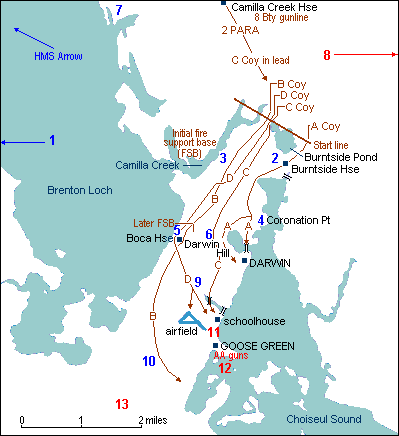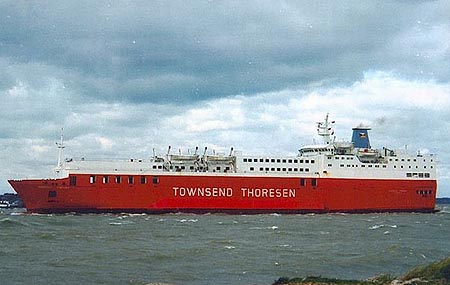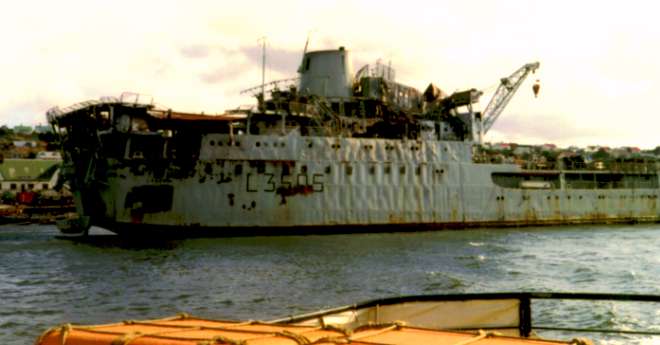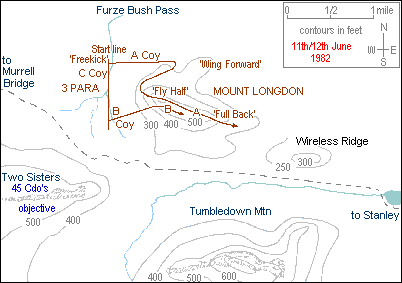Week six
3rd May(mon)
Departures: HMS Valiant, Courageous, Ambuscade,
as patrol vessel "Alferez Sobral" searched for the crew of the downed Canberra to the north of the Falklands, she was detected by a 826Sqn Sea King. Fired on, the helicopter called for help and from a range of eight miles, HMS Coventry's Lynx fired two of the new Sea Skua missiles, followed shortly by two more from HMS Glasgow's Lynx. Badly damaged and with eight crew dead, the "Sobral" was escorted into Puerto Deseado two days later, but the Canberra's crew was never found.
9 Harrier GR3 arrive in ascension after 9 hour flight from RAF Wittering.
Argentine patrol ship Alferez Sobral damaged 70 miles north of East Falkland island
Argentine aircraft lost near Stanley - Aermacchi MB-339A crashed in bad weather near the airfield killing the pilot
4th May(tues)
Departures: Alvega, Eburna
Black Buck 2. A second raid on Stanley Airfield, however none of the bombs impacted the Runway on this occasion.

destroyer "Sheffield" was hit by an air-launched Exocet SHEFFIELD hit at 52°45'S, 57°25'W.By late Tuesday morning (4th) the CVBG was 70 miles to the south east of Stanley. Aware of the Exocet threat, frigates "Brilliant" and "Broadsword" with their point defence Sea Wolf stayed in close to the carriers. Near them was a screen of three RFA's, further out a second one of "Glamorgan" and three more frigates, and then twenty miles ahead, the three type 42's including "Sheffield" with their high altitude Sea Darts. Finally towards the Falklands, Sea Harriers of No.801 flew CAP and at this time investigated a number of possible air contacts. efore then a CANA Neptune had picked up the ships by radar and two Super Etendards of 2 Esc took off from Rio Grande each armed with an Exocet AM.39. Refuelled by a Grupo 1 Hercules, they flew in at low altitude, popped-up for a radar check and released the missiles from 20 to 30 miles. One of the Exocet may just have missed "Yarmouth", but the other slammed with hardly any warning into "Sheffield" soon after 11.00 am. Hitting amidships, the warhead did not explode, but the impact and unused fuel started uncontrollable fires. Badly damaged and with little power, frigate "Arrow" soon came alongside to assist and "Yarmouth" stood by. Captain Salt's crew fought gallantly to save their ship, but with 20 men dead, the order to abandon was given that afternoon. With the wounded already on board "Hermes", "Arrow" took off most of the 260 survivors and "Sheffield" drifted for four days until "Yarmouth" was ordered to pull her clear of the TEZ.The survivors later returned to Ascension on tanker "British Esk".
Argentine aircraft lost near Stanley - PNA Skyvan at the airfield was badly damaged in another bombardment by HMS Glamorgan, HMS Alacrity and HMS Arrow.
British Aircraft lost at Goose Green: Sea Harrier. Three 800Sqn Sea Harriers from "Hermes" attacked Goose Green airstrip with CBU's and retard bombs. Little damage was done, but one aircraft was hit by Skyguard-directed 35mm Oerlikon fire and crashed killing the pilot
Most of the TF.79 ships were returning to port by Tuesday and "25° de Mayo" disembarked her aircraft. Although submarine "San Luis" stayed out a few more days, the rest of the Navy kept well clear of the British nuclear subs. However to the south of the Falklands a number of ships joined in the search for "Belgrano's" survivors with most of them returning on Wednesday.
5th May(wed)
HMS Intrepid and Atlantic Conveyer arrive in ascension. Conveyer takes on board 6 GR3 and 8 sea Harrier


6th May(thurs)
Canberra and Elk Departed Ascension with 40 and 42 Cdo RM and 3 Para, with Sea King HC4s deployed aboard.
British aircraft lost at 53°S, 57°W - Sea Harriers. Two 801Sqn Sea Harriers on CAP were sent to check a radar contact and just disappeared without trace after presumably colliding in the poor visibility
7th May(fri)
Arriving in Ascension: Europic Ferry, Norland(with 2 Para). Departed same day with amphibous Group.
TEZ - extended to within 12 miles of Argentine coast
8th May(sat)
Departures: Saxonia
With the Task Force back on the offensive, frigate "Alacrity" bombarded the Stanley area as "Brilliant" and her Lynx entered the north end of Falkland Sound to intercept any supply ships. Meanwhile "Coventry" and "Broadsword" had moved closer to Stanley with the unenviable job of tempting out Argentine aircraft.
9th May(sun)
Departures: Baltic Ferry, Nordic Ferry(with 5 Brigade)
RFA "Blue Rover" to Cumberland Bay to take up her duties as station tanker.
Argentine intelligence trawler Narwhal damaged 60 miles SE of Stanley and later sank.Two 800Sqn aircraft left "Hermes" to bomb Stanley. Stopped by cloud cover, they detected intelligence trawler "Narwal" on the way back and were given permission to attack by control ship "Coventry". Strafing failed to stop her and the high-altitude fuzed bombs were dropped, one of which hit without exploding. With the trawler at a standstill, 820Sqn and 846Sqn Sea Kings flew an SBS party some 150 miles to capture her, but before arriving, two more 800sqn Sea Harriers attacked and further damaged "NARWAL" with cannon fire. The SBS boarding went ahead, but next day she sank in tow with one crewman dead.
Argentine aircraft lost off South Jason Island - Skyhawks.HMS Coventry fired three Sea Darts at distant aircraft, including a Hercules on a supply run to Stanley, and apparently missed. However around this time, two Grupo 4 Skyhawks were lost. They may have been hit by the Sea Darts or alternatively crashed in low visibility on their way to attack the two ships. Whatever the case, one of them was later found on South Jason Island. Then in the afternoon, as an Army Puma headed out over Choiseul Sound to search for "Narwal", another Sea Dart fired at extreme range brought her down with the loss of all on board
3rd May(mon)
Departures: HMS Valiant, Courageous, Ambuscade,
as patrol vessel "Alferez Sobral" searched for the crew of the downed Canberra to the north of the Falklands, she was detected by a 826Sqn Sea King. Fired on, the helicopter called for help and from a range of eight miles, HMS Coventry's Lynx fired two of the new Sea Skua missiles, followed shortly by two more from HMS Glasgow's Lynx. Badly damaged and with eight crew dead, the "Sobral" was escorted into Puerto Deseado two days later, but the Canberra's crew was never found.
9 Harrier GR3 arrive in ascension after 9 hour flight from RAF Wittering.
Argentine patrol ship Alferez Sobral damaged 70 miles north of East Falkland island
Argentine aircraft lost near Stanley - Aermacchi MB-339A crashed in bad weather near the airfield killing the pilot
4th May(tues)
Departures: Alvega, Eburna
Black Buck 2. A second raid on Stanley Airfield, however none of the bombs impacted the Runway on this occasion.

destroyer "Sheffield" was hit by an air-launched Exocet SHEFFIELD hit at 52°45'S, 57°25'W.By late Tuesday morning (4th) the CVBG was 70 miles to the south east of Stanley. Aware of the Exocet threat, frigates "Brilliant" and "Broadsword" with their point defence Sea Wolf stayed in close to the carriers. Near them was a screen of three RFA's, further out a second one of "Glamorgan" and three more frigates, and then twenty miles ahead, the three type 42's including "Sheffield" with their high altitude Sea Darts. Finally towards the Falklands, Sea Harriers of No.801 flew CAP and at this time investigated a number of possible air contacts. efore then a CANA Neptune had picked up the ships by radar and two Super Etendards of 2 Esc took off from Rio Grande each armed with an Exocet AM.39. Refuelled by a Grupo 1 Hercules, they flew in at low altitude, popped-up for a radar check and released the missiles from 20 to 30 miles. One of the Exocet may just have missed "Yarmouth", but the other slammed with hardly any warning into "Sheffield" soon after 11.00 am. Hitting amidships, the warhead did not explode, but the impact and unused fuel started uncontrollable fires. Badly damaged and with little power, frigate "Arrow" soon came alongside to assist and "Yarmouth" stood by. Captain Salt's crew fought gallantly to save their ship, but with 20 men dead, the order to abandon was given that afternoon. With the wounded already on board "Hermes", "Arrow" took off most of the 260 survivors and "Sheffield" drifted for four days until "Yarmouth" was ordered to pull her clear of the TEZ.The survivors later returned to Ascension on tanker "British Esk".
Argentine aircraft lost near Stanley - PNA Skyvan at the airfield was badly damaged in another bombardment by HMS Glamorgan, HMS Alacrity and HMS Arrow.
British Aircraft lost at Goose Green: Sea Harrier. Three 800Sqn Sea Harriers from "Hermes" attacked Goose Green airstrip with CBU's and retard bombs. Little damage was done, but one aircraft was hit by Skyguard-directed 35mm Oerlikon fire and crashed killing the pilot
Most of the TF.79 ships were returning to port by Tuesday and "25° de Mayo" disembarked her aircraft. Although submarine "San Luis" stayed out a few more days, the rest of the Navy kept well clear of the British nuclear subs. However to the south of the Falklands a number of ships joined in the search for "Belgrano's" survivors with most of them returning on Wednesday.
5th May(wed)
HMS Intrepid and Atlantic Conveyer arrive in ascension. Conveyer takes on board 6 GR3 and 8 sea Harrier


6th May(thurs)
Canberra and Elk Departed Ascension with 40 and 42 Cdo RM and 3 Para, with Sea King HC4s deployed aboard.
British aircraft lost at 53°S, 57°W - Sea Harriers. Two 801Sqn Sea Harriers on CAP were sent to check a radar contact and just disappeared without trace after presumably colliding in the poor visibility
7th May(fri)
Arriving in Ascension: Europic Ferry, Norland(with 2 Para). Departed same day with amphibous Group.
TEZ - extended to within 12 miles of Argentine coast
8th May(sat)
Departures: Saxonia
With the Task Force back on the offensive, frigate "Alacrity" bombarded the Stanley area as "Brilliant" and her Lynx entered the north end of Falkland Sound to intercept any supply ships. Meanwhile "Coventry" and "Broadsword" had moved closer to Stanley with the unenviable job of tempting out Argentine aircraft.
9th May(sun)
Departures: Baltic Ferry, Nordic Ferry(with 5 Brigade)
RFA "Blue Rover" to Cumberland Bay to take up her duties as station tanker.
Argentine intelligence trawler Narwhal damaged 60 miles SE of Stanley and later sank.Two 800Sqn aircraft left "Hermes" to bomb Stanley. Stopped by cloud cover, they detected intelligence trawler "Narwal" on the way back and were given permission to attack by control ship "Coventry". Strafing failed to stop her and the high-altitude fuzed bombs were dropped, one of which hit without exploding. With the trawler at a standstill, 820Sqn and 846Sqn Sea Kings flew an SBS party some 150 miles to capture her, but before arriving, two more 800sqn Sea Harriers attacked and further damaged "NARWAL" with cannon fire. The SBS boarding went ahead, but next day she sank in tow with one crewman dead.
Argentine aircraft lost off South Jason Island - Skyhawks.HMS Coventry fired three Sea Darts at distant aircraft, including a Hercules on a supply run to Stanley, and apparently missed. However around this time, two Grupo 4 Skyhawks were lost. They may have been hit by the Sea Darts or alternatively crashed in low visibility on their way to attack the two ships. Whatever the case, one of them was later found on South Jason Island. Then in the afternoon, as an Army Puma headed out over Choiseul Sound to search for "Narwal", another Sea Dart fired at extreme range brought her down with the loss of all on board
















 tanley airfield was bombed by a Vulcan for the final time.
tanley airfield was bombed by a Vulcan for the final time. 
Comment